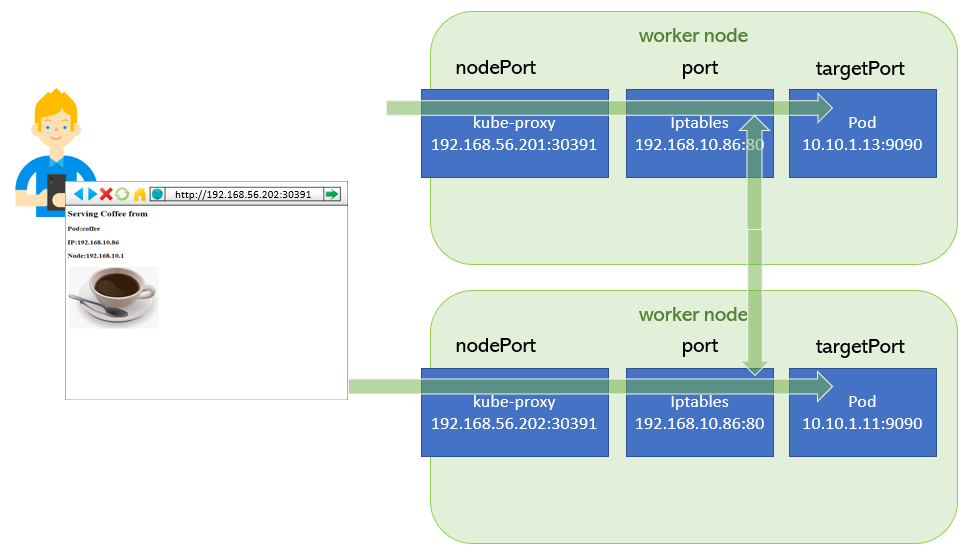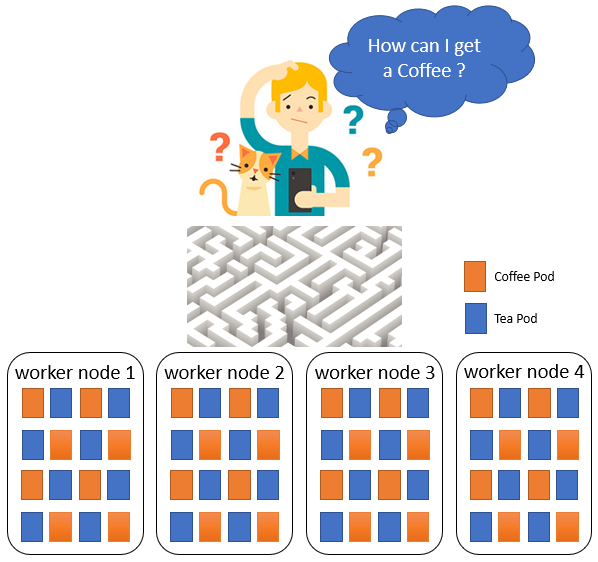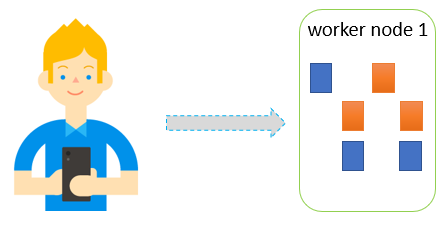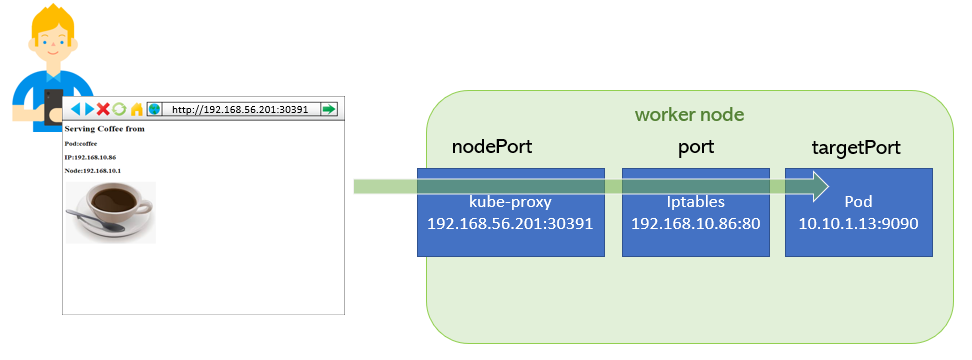Subsections of Services
Expose services in Pod
Service
A Coffee Pod running in cluster and its listening on port 9090 on Pod’s IP. How can we expose that service to external world so that users can access it ?
We need to expose the service.
As we know , the Pod IP is not routable outside of the cluster. So we need a mechanism to reach the host’s port and then that traffic should be diverted to Pod’s port.
Lets create a Pod Yaml first.
$ vi coffe.yamlapiVersion: v1
kind: Pod
metadata:
name: coffee
spec:
containers:
- image: ansilh/demo-coffee
name: coffeeCreate Yaml
$ kubectl create -f coffe.yamlExpose the Pod with below command
$ kubectl expose pod coffee --port=80 --target-port=9090 --type=NodePortThis will create a Service object in kubernetes , which will map the Node’s port 30836 to Service IP/Port 192.168.10.86:80
We can see the derails using kubectl get service command
$ kubectl get service
NAME TYPE CLUSTER-IP EXTERNAL-IP PORT(S) AGE
coffee NodePort 192.168.10.86 <none> 80:30391/TCP 6s
kubernetes ClusterIP 192.168.10.1 <none> 443/TCP 26hWe can also see that the port is listening and kube-proxy is the one listening on that port.
$ sudo netstat -tnlup |grep 30836
tcp6 0 0 :::30391 :::* LISTEN 2785/kube-proxyNow you can open browser and access the Coffee app using URL http://192.168.56.201:30391
Ports in Service Objects
nodePort
This setting makes the service visible outside the Kubernetes cluster by the node’s IP address and the port number declared in this property. The service also has to be of type NodePort (if this field isn’t specified, Kubernetes will allocate a node port automatically).
port
Expose the service on the specified port internally within the cluster. That is, the service becomes visible on this port, and will send requests made to this port to the pods selected by the service.
targetPort
This is the port on the pod that the request gets sent to. Your application needs to be listening for network requests on this port for the service to work.
NodePort
NodePort Exposes the service on each Node’s IP at a static port (the NodePort). A ClusterIP service, to which the NodePort service will route, is automatically created. You’ll be able to contact the NodePort service, from outside the cluster, by requesting
How nodePort works
kube-proxy watches the Kubernetes master for the addition and removal of Service and Endpoints objects.
(We will discuss about Endpoints later in this session.)
For each Service, it opens a port (randomly chosen) on the local node. Any connections to this “proxy port” will be proxied to one of the Service’s backend Pods (as reported in Endpoints). Lastly, it installs iptables rules which capture traffic to the Service’s clusterIP (which is virtual) and Port and redirects that traffic to the proxy port which proxies the backend Pod.
nodePort workflow.
nodePort->30391port->80targetPort->9090
ClusterIP
It exposes the service on a cluster-internal IP.
When we expose a pod using kubectl expose command , we are creating a service object in API.
Choosing this value makes the service only reachable from within the cluster. This is the default ServiceType.
We can see the Service spec using --dry-run & --output=yaml
$ kubectl expose pod coffee --port=80 --target-port=9090 --type=ClusterIP --dry-run --output=yaml
Output
apiVersion: v1
kind: Service
metadata:
creationTimestamp: null
labels:
run: coffee
name: coffee
spec:
ports:
- port: 80
protocol: TCP
targetPort: 9090
selector:
run: coffee
type: ClusterIP
status:
loadBalancer: {}Cluster IP service is useful when you don’t want to expose the service to external world. eg:- database service.
With service names , a frontend tier can access the database backend without knowing the IPs of the Pods.
CoreDNS (kube-dns) will dynamically create a service DNS entry and that will be resolvable from Pods.
Verify Service DNS
Start debug-tools container which is an alpine linux image with network related binaries
$ kubectl run debugger --image=ansilh/debug-tools --restart=Never$ kubectl exec -it debugger -- /bin/sh
/ # nslookup coffee
Server: 192.168.10.10
Address: 192.168.10.10#53
Name: coffee.default.svc.cluster.local
Address: 192.168.10.86
/ # nslookup 192.168.10.86
86.10.168.192.in-addr.arpa name = coffee.default.svc.cluster.local.
/ #coffee.default.svc.cluster.local
^ ^ ^ k8s domain
| | | |-----------|
| | +--------------- Indicates that its a service
| +---------------------- Namespace
+----------------------------- Service NameLoadBalancer
Exposes the service externally using a cloud provider’s load balancer. NodePort and ClusterIP services, to which the external load balancer will route, are automatically created.
We will discuss more about this topic later in this training.
Endpoints
Pods behind a service.

 Lets
Lets describe the service to see how the mapping of Pods works in a service object.
(Yes , we are slowly moving from general wordings to pure kubernetes terms)
$ kubectl describe service coffee
Name: coffee
Namespace: default
Labels: run=coffee
Annotations: <none>
Selector: run=coffee
Type: NodePort
IP: 192.168.10.86
Port: <unset> 80/TCP
TargetPort: 9090/TCP
NodePort: <unset> 30391/TCP
Endpoints: 10.10.1.13:9090
Session Affinity: None
External Traffic Policy: ClusterHere the label run=coffee is the one which creates the mapping from service to Pod.
Any pod with label run=coffee will be mapped under this service.
Those mappings are called Endpoints.
Lets see the endpoints of service coffee
$ kubectl get endpoints coffee
NAME ENDPOINTS AGE
coffee 10.10.1.13:9090 3h48mAs of now only one pod endpoint is mapped under this service.
lets create one more Pod with same label and see how it affects endpoints.
$ kubectl run coffee01 --image=ansilh/demo-coffee --restart=Never --labels=run=coffeeNow we have one more Pod
$ kubectl get pods
NAME READY STATUS RESTARTS AGE
coffee 1/1 Running 0 15h
coffee01 1/1 Running 0 6sLets check the endpoint
$ kubectl get endpoints coffee
NAME ENDPOINTS AGE
coffee 10.10.1.13:9090,10.10.1.19:9090 3h51mNow we have two Pod endpoints mapped to this service. So the requests comes to coffee service will be served from these pods in a round robin fashion.


